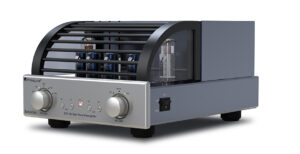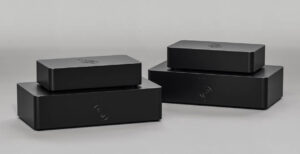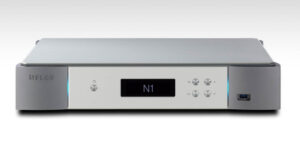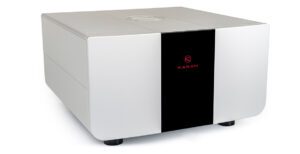
We keep beginning these reviews of state-of-the-art digital products with variations on the theme of ‘how the digital world is changing’ for a reason: it IS changing. Moon’s prestigious Evolution range is perfectly indicative of that change. The digital top spot in Moon’s top range used to be held by the 750D CD player, but this year that was ousted by the Evolution 780D, a combined digital converter and network streamer.
CD players – essentially DACs with CD transport mechanisms – remain in the Moon catalogue, but it’s possible these players are the last of their line and subsequent generations of Moon digital products will evolve from the 780D (well, an ‘Evolution’ pun was irresistible). In fact, it’s already happening; products that have a direct link to the 780D design brief have already begun to appear in Moon’s more affordable NEO range.
Viewed on a surface level, the Evolution 780D is a nine-input digital converter, already next-gen ready thanks to its USB, Ethernet, Wi-Fi, and aptX Bluetooth connections, alongside the optical and coaxial S/PDIF and AES/EBU inputs. It’s a dual-differential DAC layout where each of the two ESS9018S Sabre DAC chips sports essentially 16 unique DAC circuits per channel that can support PCM to 24-bit, 384kHz and DSD to quad-speed/256. In other words, it can support bleeding-edge formats, for which there are but a handful of tracks. Nevertheless, the logic behind this is if it can process at this resolution, 24/192 and DSD 64 should be a breeze. While I’m not wholly convinced of the need for this endless specification arms race given the paucity of music available in astronomic-resolution, there doesn’t seem to be much sign of a ceasefire yet. Irrespective of file format, the Evolution 780D also features a Femtosecond-grade internal clock, to show jitter who’s boss.
Moon has started a move to a new Hybrid Power (MHP) supply in the 780D, a high performance universal Power Supply using conductive polymer parts, high speed digital switching, and analogue linear regulators post stages designed to smooth the DC output. With an increasing number of DAC designs going switch-mode only, which works well for digital stages, it’s great to see a digital device take its analogue side just as seriously.
The net result of all this taking power seriously does have its downside – acronyms! The dozen stages of DC voltage regulation include two M-LoVo (Moon Low Voltage Regulation) stages and four I2DCf (Independent Inductive DC filtering) stages. All connected with SimLink comms. And probably a PIAPT (Partridge In A Pear Tree) somewhere, too.
Elsewhere, the 780D is all aircraft-grade aluminium, super-thick PCBs, isolating corners, and the kind of last-a-lifetime, you could drive a tank over it build we have come to expect from Moon’s top Evolution range. It also has Moon’s trademark huge red LED front panel readout. It features balanced and single-ended analogue outputs; we preferred single-ended, but not by much.
Integral to the 780D is MiND, or Moon intelligent Network Device. Originally a standalone box, designed to allow more conventional DAC devices to talk to local and internet networked audio, MiND is now becoming integrated into the company’s latest digital products. MiND was one of the first ways of streaming DSD files over Ethernet, and many still consider it the best in terms of flexibility. In particular, MiND and the accompanying app integrate with network streaming service TIDAL in a way few other hardware companies have achieved. This redefines the term ‘seamless’ when it comes to integration of local and online music services. The 780D’s open-ended design suggests that should the need arise to upgrade the DAC or the MiND stages, upgrades and updates will be made available (and Moon does have some ‘form’ in providing such updates, so the idea of future updates is not idle speculation).
On the subject of improvements, several of the top tier products in Moon’s Evolution range can be upgraded using the company’s external 820S power supply. The 780D is no exception, but we didn’t have this to hand. Neither, at the time of test, did we have a Moon amplifier to try out the SimLink communications hook-up between the two devices. However, on past experience, this is a wonderfully integrated connection between linked devices, with control surfaces, functionality, equalised level LED dimming, even cascaded power up and power down routines, passed perfectly and effortlessly from product to product. I have no reason to believe the 780D would behave out of the ordinary here. For Moon devices, that is.
That throwaway end of the last paragraph is actually a pivotal function of Moon’s equipment. Taken alone or together, they work in the way you would expect audio components to work. You don’t need an electronics degree to switch the device on, and you don’t need to pray for a miracle that when you turn it on, it hasn’t permanently locked you out of three-quarters of its functionality. The 780D is an undeniably complex, multifunction piece of electronics engineering, so it’s never going to be as easy to use as a toaster. It requires some installation skills and some understanding of how to create a home network to operate it at its best. If you can’t do that personally, ask your dealer, who will then get his 13 year old son (who can do this kind of stuff in his sleep) to configure and create a network for you. Ultimately, you will end up with some kind of network attached storage, to which you will rip some of your CD collection, before giving up on the whole project and signing up to TIDAL, which you can also do through the network and on the Moon app.
Installation is not – by modern standards – complex, and once your MiND network is up and running, you’ll begin to look at those CD-spinning days with incredulity, rather than nostalgia. It quickly becomes a ‘did I used to do that?’ mindset. I’ve recently started listening to CD anew thanks to the dCS Rossini, and the 780D makes a very fine DAC in and of itself, but it also makes a fine argument for putting CD back in its jewel case and stowing it away because the 780D delivers some of the finest streamed sounds I have ever experienced. CD is still great, and still sounds great, but the 780D extracts the musical marrow from all file types!
Like the 750D CD player before it, the 780D makes music with great authority. The 780D begins with its spatial properties, establishing a fine soundstage of great width and precision. It doesn’t matter what music you are playing here, if it has any kind of stage, the 780D will present it well. I played ‘She Talks To Angels’ by The Black Crowes [Shake Your Money Maker, American], which isn’t the first choice for portraying deep soundstage (the guitar and vocals are close mic’d and the rest of the band seems to appear as a thin layer of musicians in the chorus), but the 780D created a surprising sense of dimensionality and solidity to the sound in the room. When you moved over to music with true soundstaging (yes, it’s an audiophile cliché, but Cannonball Adderley’s Somethin’ Else [Blue Note] is a perfect album to play here), you could place yourself in the studio with the musicians, such is the size and precision of the 780D’s staging properties.
The great thing about the 780D is that it doesn’t have that thin, stark, and forward sound so common to ‘next-gen’ audio equipment at this time. The sound digital produces is extremely detailed, highly coherent, and very articulate, but somewhere in the transition from disc-based to file-based music we seem to have forgotten that music is more than shots; it’s there to be drunk deep. Not here though. The 780D has music wired into its DNA: you don’t listen to minute long ‘Classical Moods’ here – you play Beethoven’s Ninth Symphony [von Karajan, Berlin Phil, DG] from beginning to end, because you are at ease with the music it plays.
There was a word that kept coming back on the notepad with the 780D. The word was ‘graceful’. It’s not used much in audio today because most music replay devices have forgotten its importance, but music flows from musical theme to theme with such passion and grace on the 780D that it’s hard not to be impressed. It’s almost analogue in intent, although this is the wrong term: it’s not trying to be vinyl, and it’s definitely a digital player, just that it has that sense of musical grace (that word again) you hear immediately on vinyl and is oh so rare on digital.
I can see there will be some who like their music with great gusto, who will find this more majestic, graceful presentation not ‘edgy’ enough. On the other hand, there are also those who find a singular obsession with music’s pulse too limiting and crass, and for them the Moon 780D’s abilities to balance tonal, timbral, and rhythmic elements with great evenness hard to resist.
Part of the Moon’s ability to move beyond the rhythmic end of the spectrum is because the next most common word on my note pad was ‘confident’. This is a big, and bold sound, at once comfortable with huge-scale orchestral works and breathy girl-with-guitar songs, and all points between. Dynamics are effortless (to the point where you stop becoming aware of a thing called dynamic range and just listen to the music) and this dynamism, and a good natural sense of melody (without accenting the beat) combined with that graceful overall presentation, makes this an easy digital device to love.
In a way, although the hardware is the power behind the throne, the one element that ultimately makes or breaks a product today are the programs and apps used to interface and control the device. The best sounding DAC with a poor app will fail to thrive. And that’s where MiND really comes into its own – the app is so good here, I could almost imagine someone buying the 780D because of the app. The best way I can describe the app is it works the way you would expect a music playing app to work, and it just happens to connect with and control one of the best sounding digital devices you can get. In fact, the Moon does come with a really nice handset with squidgy touch buttons that glow every time you pick it up (it has an accelerometer inside), and eight touch buttons on the front panel, but the moment you power up the app, those elements become redundant.
In fact, the only real limitation to the 780D is that well documented running in period that applies universally to all Moon devices. If you get a demonstration, make sure the store has given the 780D plenty of time to get its act together. That includes not leaving it unpowered for any significant time. When you get it home, it will sound pretty good out of the box. Weeks later, you’ll suddenly relax into the 780D’s performance more than you have before, and at that point it’s about half way there. I’ve had a few ‘wow!’ moments along the way with the 780D and – from experience with Moon products – I’m about a third of the way through the whole warming up process. Check back next year, and those early adopter 780D users will be absolutely blissed out. Over the Moon, in fact!
The Moon Evolution 780D is something to get excited about, even if you might never get close to being able to afford one. It deserves that excitement not just because it sounds damn good, not just because it works so well, but also because it shows us all the right way to do audio in 2015. It’s a complete digital solution in a world of half-finished audio jigsaw puzzles. It’s a template for engineers to create a new generation of products that actually work as they should work, and it’s a call to arms for enthusiasts to demand this level of professionalism from the manufacturers, whether you are spending £100 or £100,000. And to those other brands, let’s make this abundantly clear: Moon got things very right with the 780D – why can’t you do the same? The 780D comes very highly recommended!
Technical Specifications
- Type: Network streaming DAC
- Digital Inputs: 1× AES/EBU XLR, 3× S/PDIF (1× BNC, 2× RCA), 1× Toslink S/PDIF, 1× USB Type B, RJ45 Ethernet, Wi-Fi/Bluetooth aerial
- Inputs: RS232, 12v trigger in/out. SimLink in/out mini-jack
- Analogue outputs: RCA stereo, XLR stereo, 2.0V rms
- Output impedance: 100 Ω
- Formats supported: PCM to 32bit, 384kHz, DSD 64, DSD 128 and DSD 256, DXD supported
- Frequency Response: 2Hz–100kHz (+0db/–3dB)
- THD: 0.0001% (@1kHz, 0dBFS)
- Intermodulation Distortion: 0.0001%
- Dynamic range: 124dB
- Signal to noise ratio: 124dB (full output 120dB)
- Jitter: 150 femtoseconds
- Finish: All black, all silver, silver with black, custom finish to order
- Dimensions (W×H×D): 47.6×10.2×42.7cm
- Weight: 16kg
- Price: £10,500
- Made by: Moon
URL: www.simaudio.com
Distributed in the UK by: Renaissance Audio
URL: www.renaissanceaudio.co.uk
Tel: 44 (0)131 555 3922
Tags: FEATURED
By Alan Sircom
More articles from this authorRead Next From Review
See all
PrimaLuna EVO 100 phono preamplifier
- Apr 22, 2024

Reiki Audio SuperSwitch Master Pro + Servant Pro
- Mar 27, 2024

Melco Audio N1-S38 music server
- Mar 27, 2024











